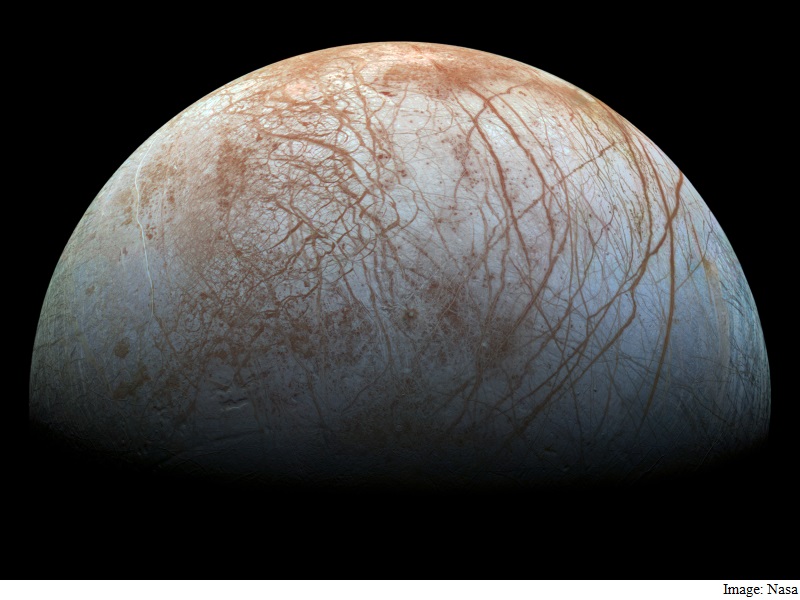- Home
- Science
- Science News
- Nasa Mulls Lander to Explore Jupiter's Moon Europa for Alien Life
Nasa Mulls Lander to Explore Jupiter's Moon Europa for Alien Life

The main focus of the launch, that may happen in as early as 2022, will mainly study Europa from the orbit but the US space agency is also exploring the idea for surface investigation, rt.com reported on Friday.
"We are actively pursuing the possibility of a lander," said Robert Pappalardo, Europa project scientist at Nasa's Jet Propulsion Laboratory (JPL) in Pasadena, California, was quoted as saying.
"Nasa has asked us to investigate: What would it take? How much would it cost? Could we put a small surface package on Europa with this mission?" Pappalardo told a panel discussion at the "Space 2015" conference earlier this month.
The final decision is expected by the end of this year, Pappalardo added.
The conditions on Europa have made the icy moon top choice on the researchers' list of finding alien life in our solar system.
Past research has shown that this icy world has a huge sub-surface ocean that is twice as deep as the deepest spot in Earth's oceans.
It has existed for billions of years, being almost as old as the solar system itself.
According to a report in Space.com, the probe will use as many as nine different ways to study the icy world, including high-resolution cameras, a heat detector and ice-penetrating radar.
Scientists believe it will give them plenty of new data about Europa's composition, the nature of its sub-surface ocean, as well as its ability to host life similar to that which we know on Earth.
The mission is also expected to serve as a reconnaissance mission to facilitate future landings, as getting to the ice world may be really challenging.
For the latest tech news and reviews, follow Gadgets 360 on X, Facebook, WhatsApp, Threads and Google News. For the latest videos on gadgets and tech, subscribe to our YouTube channel. If you want to know everything about top influencers, follow our in-house Who'sThat360 on Instagram and YouTube.
Related Stories
- Amazon Great Indian Festival 2024
- Big Billion Days 2024
- Apple Vision Pro
- Oneplus 12
- iPhone 14
- Apple iPhone 15
- OnePlus Nord CE 3 Lite 5G
- iPhone 13
- Xiaomi 14 Pro
- Oppo Find N3
- Tecno Spark Go (2023)
- Realme V30
- Best Phones Under 25000
- Samsung Galaxy S24 Series
- Cryptocurrency
- iQoo 12
- Samsung Galaxy S24 Ultra
- Giottus
- Samsung Galaxy Z Flip 5
- Apple 'Scary Fast'
- Housefull 5
- GoPro Hero 12 Black Review
- Invincible Season 2
- JioGlass
- HD Ready TV
- Laptop Under 50000
- Smartwatch Under 10000
- Latest Mobile Phones
- Compare Phones
- Realme Note 60x
- Honor X9c Smart
- Realme V60 Pro
- iQOO Neo 10
- iQOO Neo 10 Pro
- Redmi K80 Pro
- Redmi K80
- Lava Yuva 4
- Asus Zenbook S 14
- MacBook Pro 16-inch (M4 Max, 2024)
- Huawei MatePad Pro 13.2
- Oppo Pad 3
- Redmi Watch 5
- Huawei Watch Ultimate Design
- Sony 65 Inches Ultra HD (4K) LED Smart TV (KD-65X74L)
- TCL 55 Inches Ultra HD (4K) LED Smart TV (55C61B)
- Sony PlayStation 5 Pro
- Sony PlayStation 5 Slim Digital Edition
- Blue Star 1.5 Ton 3 Star Inverter Split AC (IC318DNUHC)
- Blue Star 1.5 Ton 3 Star Inverter Split AC (IA318VKU)

















